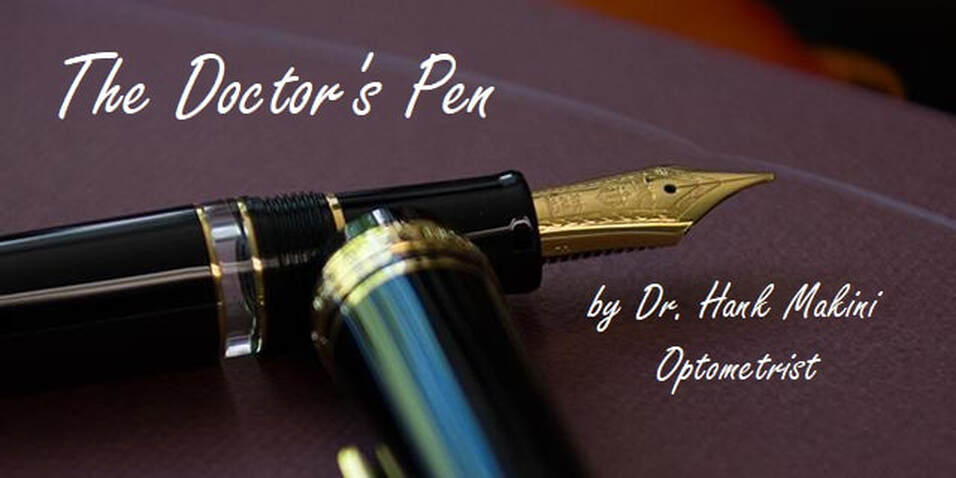Its never too early to know how your child sees, but it can be TOO late
to know what they're missing... in school and in life!
by Dr. Hank Makini
There are approximately seven to ten million children between the ages of three to five being treated for ADHD. At the same time statistics also indicate that one out of every four children may possibly have an undetected visual characteristic that leads them to poor concentration, poor academic performance and negative behavioral changes. What does this mean? It means that a child with an undetected visual characteristic could tragically be misdiagnosed and unnecessarily medicated for an ADHD condition that does not exist.
I wish this was only a speculation but it's not, it's a reality! Can you imagine a mom sitting by herself before three educators and three health professionals being told that she has to medicate her 8 year old son and if she chooses not to, her son would not be allowed to return to school and her name would be given to CPS? I've seen first hand what this can do to good and responsible parents! I've seen other parents with their hearts broken because their children were forced to take ADHD medication that made them feel awful and gave no significant improvements academically. An undetected visual problem left untreated ultimately means that a child's potential bright future is now simply thrown away!
Therefore, without the knowledge of vision and it's critical importance in learning and concentration, students are too easily and conveniently considered for learning disabilities and ADHD which treatments with either special education or strong psychiatric medications are destructive. And believe me there are consequences. I've seen a parent in tears because their child couldn't be taught to read not by one but two separate special education programs.
In schools today, visual problems are no longer ruled out as a possible cause for poor academics and behavior in students. Decades ago they were considered, but unfortunately, those times have gone. Psychology has unintentionally overshadowed the importance of the basic fundamentals of seeing and hearing. It began in the 1990's when the Federal government had implemented a modified medical program to address ADD and ADHD in schools and allowed a different definition of the term 'Diagnosis' to exist. Unlike medicine, where a diagnosis is arrived at through a differential process involving the ruling out of other possible causes. School systems were given the authority to identify (diagnose) ADHD in children when 7 out of a list of 9 behaviors are agreed upon to exist in that child by a group usually consisting of educators and assigned health advisors including state-hired pediatricians, psychologists and psychiatrists. Without proper differential testing including an effective visual evaluation by an specially trained optometrist, this medically modified program is a mis-identification (misdiagnosis) just waiting to happen!
Project S.A.V.E. is a public awareness project founded by Dr. Makini that stands for 'Supporting Academic & Visual Excellence.' Its purpose is to protect our children from this life-altering misfortune! Dr. Makini has created a children's visual care approach called Academic Vision Care that can determine if a child is being misidentified.
Dr. Makini - "It should never be just about the behavior only, but should include the successful academic development of the child. In reality, there aren't many health professionals best suited for this kind of problem. The behavioral optometrist, like myself, would be the closest in helping parents to find a solution for their child. This type of problem, although still relatively new, is unfortunately becoming more and more common place. We need more optometrists and pediatricians to be made aware of this devastating problem, how to identify them and how to get them the care they truly need!"
If you've any questions, need to acquire more information or would like to have Dr. Makini speak at your next gathering, please call 808-674-0744. You may also reach Dr. Makini at [email protected].
to know what they're missing... in school and in life!
by Dr. Hank Makini
There are approximately seven to ten million children between the ages of three to five being treated for ADHD. At the same time statistics also indicate that one out of every four children may possibly have an undetected visual characteristic that leads them to poor concentration, poor academic performance and negative behavioral changes. What does this mean? It means that a child with an undetected visual characteristic could tragically be misdiagnosed and unnecessarily medicated for an ADHD condition that does not exist.
I wish this was only a speculation but it's not, it's a reality! Can you imagine a mom sitting by herself before three educators and three health professionals being told that she has to medicate her 8 year old son and if she chooses not to, her son would not be allowed to return to school and her name would be given to CPS? I've seen first hand what this can do to good and responsible parents! I've seen other parents with their hearts broken because their children were forced to take ADHD medication that made them feel awful and gave no significant improvements academically. An undetected visual problem left untreated ultimately means that a child's potential bright future is now simply thrown away!
Therefore, without the knowledge of vision and it's critical importance in learning and concentration, students are too easily and conveniently considered for learning disabilities and ADHD which treatments with either special education or strong psychiatric medications are destructive. And believe me there are consequences. I've seen a parent in tears because their child couldn't be taught to read not by one but two separate special education programs.
In schools today, visual problems are no longer ruled out as a possible cause for poor academics and behavior in students. Decades ago they were considered, but unfortunately, those times have gone. Psychology has unintentionally overshadowed the importance of the basic fundamentals of seeing and hearing. It began in the 1990's when the Federal government had implemented a modified medical program to address ADD and ADHD in schools and allowed a different definition of the term 'Diagnosis' to exist. Unlike medicine, where a diagnosis is arrived at through a differential process involving the ruling out of other possible causes. School systems were given the authority to identify (diagnose) ADHD in children when 7 out of a list of 9 behaviors are agreed upon to exist in that child by a group usually consisting of educators and assigned health advisors including state-hired pediatricians, psychologists and psychiatrists. Without proper differential testing including an effective visual evaluation by an specially trained optometrist, this medically modified program is a mis-identification (misdiagnosis) just waiting to happen!
Project S.A.V.E. is a public awareness project founded by Dr. Makini that stands for 'Supporting Academic & Visual Excellence.' Its purpose is to protect our children from this life-altering misfortune! Dr. Makini has created a children's visual care approach called Academic Vision Care that can determine if a child is being misidentified.
Dr. Makini - "It should never be just about the behavior only, but should include the successful academic development of the child. In reality, there aren't many health professionals best suited for this kind of problem. The behavioral optometrist, like myself, would be the closest in helping parents to find a solution for their child. This type of problem, although still relatively new, is unfortunately becoming more and more common place. We need more optometrists and pediatricians to be made aware of this devastating problem, how to identify them and how to get them the care they truly need!"
If you've any questions, need to acquire more information or would like to have Dr. Makini speak at your next gathering, please call 808-674-0744. You may also reach Dr. Makini at [email protected].

